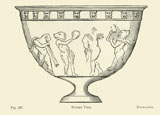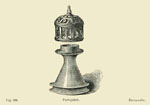Previous First Next
SALAMIS IN THE ISLAND OF CYPRUS.
BY ALEXANDER PALMA DI CESNOLÀ, F.S.A.,
page 123
Professional players on the harp and pipe are not uncommon subjects upon painted vases (Birch, Hist., 284). A  capacious goblet-shaped Roman vase (fig. 297) has a frieze or upper border of masks or faces, evidently satirical, and the subject painted upon the body appears to be a parody or burlesque of some scene, perhaps of the myth of Circe, the enchantress, in the ancient theatre. It is well known that parody and caricature of myths and historicallegends were largely introduced among the subjects of later painted vases. The subject on the reverse side of this remarkable relic is reproduced in fig. 298. capacious goblet-shaped Roman vase (fig. 297) has a frieze or upper border of masks or faces, evidently satirical, and the subject painted upon the body appears to be a parody or burlesque of some scene, perhaps of the myth of Circe, the enchantress, in the ancient theatre. It is well known that parody and caricature of myths and historicallegends were largely introduced among the subjects of later painted vases. The subject on the reverse side of this remarkable relic is reproduced in fig. 298.
It may possibly represent a scene in connection with some of the ancient Mystexies; subjects relating to these being of sufficient frequency and importance to be placed by Millingen in a separate class in his classification of vases. It is 21 in. high, and 15 in. broad. I am now compelled, by want of space, to conclude these  chapters upon the terra-cottas, which might have been easily augmented in size had I described all the interesting points in the vast collection of fictiliathat the fertile soil of Salamis has, not without trouble and fatigue, yielded to the Lawrence- Cesnola collection. It has been my aim on this occasion, not so much to dilate upon every specimen which I was fortunately enabled to rescue from the silent site where it has slept for hundreds or thousands of years, as to put before the indulgent reader my own account of the points and details which seem to me to be most marked, and to call more especially for pictorial or descriptive illustration. By these means I have endeavoured to convey to the archaeologist a faithful idea of the ways and means of domestic life in the ancient days of Cyprus, mirrored alone, as is the case with other ancient sites, in the sepulchral surroundings of the shadowy homes of the dead. The field of Greek and Roman archaeology had been, we are told by one who stands in the first rank as the historian of ancient pottery, almost exhausted by the labours of the learned for two centuries; but the discoveries which recent excavations in Cyprus have revealed, have thrown a new glamour over the ardour with which researches into early and archaic features of any art have always been prosecuted, and in some cases a modification of hitherto accepted opinions has resulted. The rearrangement of the archaic pottery of Hellenic origin in the new " First Vase Room" of the British Museum is an important outcome of the hypogeal harvest which those who have eyes to see may gather plenteously in the island of Cyprus; and a very cursory inspection of that richly-freighted room is sufficient to show how greatly the island contributes to the unrivalled exhibition there made of early strivings of human art in this particular direction— trammelled bv technical difficulties in its inception, influenced by a nascent feeling chapters upon the terra-cottas, which might have been easily augmented in size had I described all the interesting points in the vast collection of fictiliathat the fertile soil of Salamis has, not without trouble and fatigue, yielded to the Lawrence- Cesnola collection. It has been my aim on this occasion, not so much to dilate upon every specimen which I was fortunately enabled to rescue from the silent site where it has slept for hundreds or thousands of years, as to put before the indulgent reader my own account of the points and details which seem to me to be most marked, and to call more especially for pictorial or descriptive illustration. By these means I have endeavoured to convey to the archaeologist a faithful idea of the ways and means of domestic life in the ancient days of Cyprus, mirrored alone, as is the case with other ancient sites, in the sepulchral surroundings of the shadowy homes of the dead. The field of Greek and Roman archaeology had been, we are told by one who stands in the first rank as the historian of ancient pottery, almost exhausted by the labours of the learned for two centuries; but the discoveries which recent excavations in Cyprus have revealed, have thrown a new glamour over the ardour with which researches into early and archaic features of any art have always been prosecuted, and in some cases a modification of hitherto accepted opinions has resulted. The rearrangement of the archaic pottery of Hellenic origin in the new " First Vase Room" of the British Museum is an important outcome of the hypogeal harvest which those who have eyes to see may gather plenteously in the island of Cyprus; and a very cursory inspection of that richly-freighted room is sufficient to show how greatly the island contributes to the unrivalled exhibition there made of early strivings of human art in this particular direction— trammelled bv technical difficulties in its inception, influenced by a nascent feeling of beauty in simple natural objects in its earlier stages of progress, and ultimately adopting, during its finest period, theforms of these very objects, and rendering them subservient to rules of conventionalism and practical utility. of beauty in simple natural objects in its earlier stages of progress, and ultimately adopting, during its finest period, theforms of these very objects, and rendering them subservient to rules of conventionalism and practical utility.
Perhaps I shall be excused for introducing at the close of this chapter an illustration of a very elegant fumigator (fig. 299), or incense-holder, with perforations to allow the escape of the scented fumes. It may be compared with one figured by Mr. Sandwith (Archǽologia, xlv).
Previous First Next
|